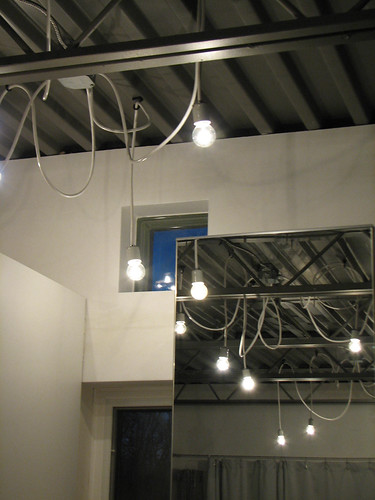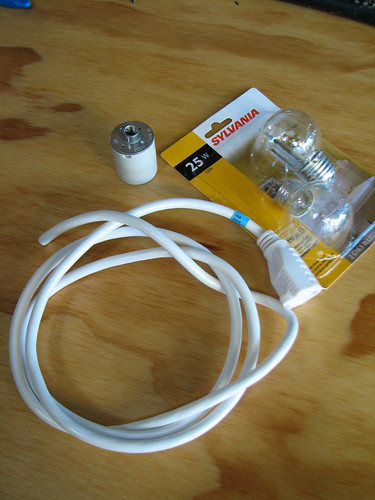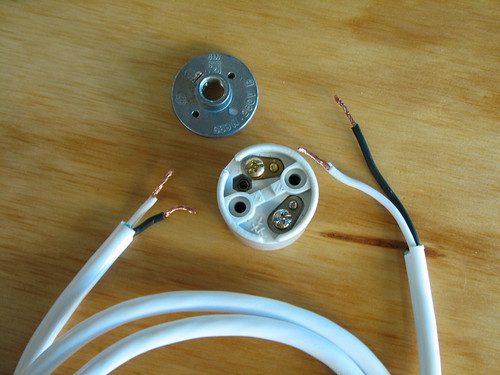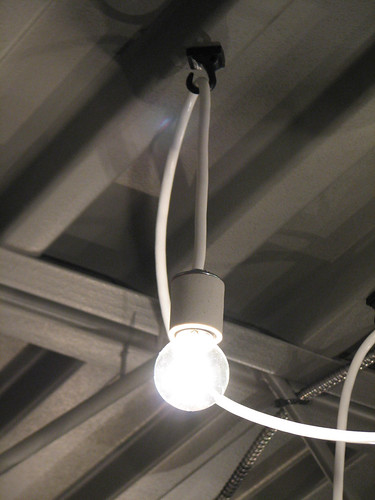Fun with Cord Lights
What does the combination of a hacked up 50 foot extension cord, a few light sockets and some 25 watt bulbs mean for Modern in MN?
Light fixtures for the bedroom, at long last! HURRAY!

The basic components:

As I said, that's just a hunk of extension cord, a porcelain light socket, and some low wattage bulbs. All of this stuff is available at hardware stores and home centers. Or, if you're buying in bulk as I was, you may find it worthwhile to look online for better pricing.

Above is what the inside of the porcelain socket looks like...
Don't forget to put that little metal escutcheon on the cord BEFORE attaching the wires to the screws.
I wired up a bunch of cords in a variety of random lengths. In my case they were getting hardwired into ceiling boxes so I left the opposite end alone, but you could also wire a plug on here to allow them to plug into a receptacle, like this:

And, leveraging the steel-decking-as-ceiling feature that figures so prominently in the decor here at Modern in MN, I found some neato little magnetic hooks to hold each of the cord lights up, making the fixtures endlessly and quickly reconfigurable.

In a regular house I'd either screw a steel plate to the ceiling wherever I wanted to put a cord and magnet, or use a stick-on hook instead. A screw-in cuphook would work too.
Now, if you think I'm crazy and that this is the ugliest answer to lighting you've ever seen, you can stop reading here. If you're someone who is likely to be inspired by this or wishes to have your own fun with cord lights, keep in mind that there are some safety points you'll want to be aware of.
Most importantly, understand the watts/amps equation and figure out how many watts of lamping you'll have in your finished project, making sure that the rating of the circuit you're using can accommodate what you plan to do. BRIEFLY, a standard, 15 amp household circuit is allowed 1440 watts, (but this does not mean that you can or should add 1440 watts of lamping). Also mind that electrical code dictates the number of wires you can have connected inside a box based on box volume and gauge of wire. A basic-ish primer on this can be found here.
When in doubt, consult a professional.
Light fixtures for the bedroom, at long last! HURRAY!

The basic components:

As I said, that's just a hunk of extension cord, a porcelain light socket, and some low wattage bulbs. All of this stuff is available at hardware stores and home centers. Or, if you're buying in bulk as I was, you may find it worthwhile to look online for better pricing.

Above is what the inside of the porcelain socket looks like...
Don't forget to put that little metal escutcheon on the cord BEFORE attaching the wires to the screws.
I wired up a bunch of cords in a variety of random lengths. In my case they were getting hardwired into ceiling boxes so I left the opposite end alone, but you could also wire a plug on here to allow them to plug into a receptacle, like this:

And, leveraging the steel-decking-as-ceiling feature that figures so prominently in the decor here at Modern in MN, I found some neato little magnetic hooks to hold each of the cord lights up, making the fixtures endlessly and quickly reconfigurable.

In a regular house I'd either screw a steel plate to the ceiling wherever I wanted to put a cord and magnet, or use a stick-on hook instead. A screw-in cuphook would work too.
Now, if you think I'm crazy and that this is the ugliest answer to lighting you've ever seen, you can stop reading here. If you're someone who is likely to be inspired by this or wishes to have your own fun with cord lights, keep in mind that there are some safety points you'll want to be aware of.
Most importantly, understand the watts/amps equation and figure out how many watts of lamping you'll have in your finished project, making sure that the rating of the circuit you're using can accommodate what you plan to do. BRIEFLY, a standard, 15 amp household circuit is allowed 1440 watts, (but this does not mean that you can or should add 1440 watts of lamping). Also mind that electrical code dictates the number of wires you can have connected inside a box based on box volume and gauge of wire. A basic-ish primer on this can be found here.
When in doubt, consult a professional.



